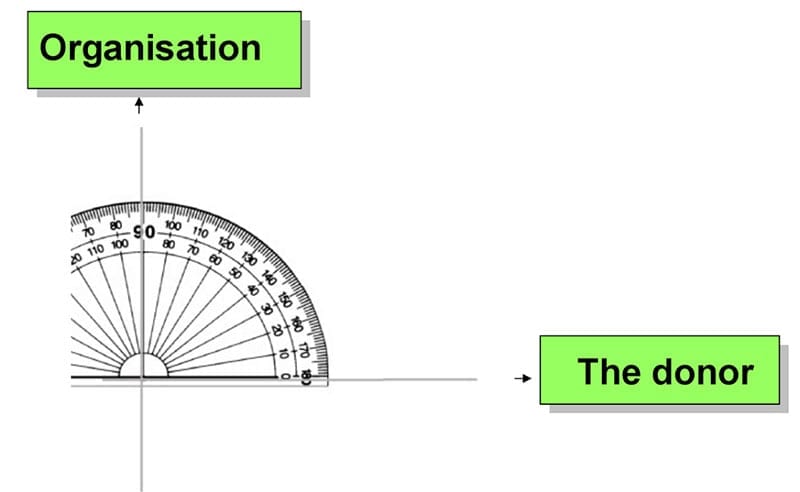What do we do now to reassure our donors?
The sum of all interactions with donors and all communications to and from them is ‘the donor experience’. Good fundraising ensures that each contact with a donor should leave the donor happier after the experience than before it.
It’s not rocket science.
We should look at fundraisers and fundraising through the eyes of the donor, to ask the questions; what do donors want, and what is most likely to inspire them to give? Radically different from other initiatives designed to regulate and protect charity income, we have a chance to put donors at the centre of charity fundraising.
Donations to the UK’s top 4129 charities contributed £12,500,000,000 in 2013. This is an enormous sector and it needs big thinking and bold investment to protect and secure income on such a scale.
Is it really different to an automobile manufacturer might do for its customers – to ask what they want from their driving experience; what kind of a car will they want to drive and what overall experience that should give them. Nobody gives money to Mercedes; they give to enjoy the driving experience. Everyone at Mercedes is working to create a car that will give the best customer experience. Is it different for fundraisers and their customers, donors?
Perhaps we’d find the surest way to increase income would be to compare the marketing of the charity, emphasising the feelings, thoughts and desires of donors, rather than the needs of the charity?
If so we should identify best practice and capture examples of it in order that these should become shared and common practice.

Image: Giles Pegram CBE
At the NSPCC a few years ago, when we were trying to become more donor-centric, we developed the concept of the 90-degree shift, the learned ability to see every aspect of our fundraising not from the perspective of our CEO, or head of finance or fundraising, but from the direct viewpoint of our individual donors. Every fundraiser, every appeals director, should make the 90-degree shift and carefully explain it to their FD and then the CEO and trustees. This is not just about being nice to donors, it‘s an investment in the long-term income from donors and supporters.
So don’t think about the needs of your charity. Think instead about the needs of your donors. Then you will meet the needs of the charity. It requires a 90 degree shift in our thinking. Recently Ken Burnett and I have been working together, thinking about and defining all that emerges from that shift in thinking.
What we might achieve
First, it will lead to more income for the causes we exist to serve.
Secondly, we’ll find ways to maintain and build trust and confidence in our donors and prospects.
Thirdly, it will lead to an enhanced reputation for fundraisers and greater fulfilment for all who work in your cause.
Fourthly, it will help to counter negative perceptions of fundraisers.
Fifthly, it will help you to identify, establish, and embed new ways of working.
Defining a new vision for fundraising
It’s clear from public reactions to the recent spate of negative press coverage that fundraisers should address the culture in fundraising.
Fundraising is about inspiring and delighting donors so that they will want to be on the fundraiser’s side. If they are, their generosity will see our causes through.
The result will be more satisfied donors, giving for longer, because they feel fulfilled about their experience as a donor.
Advertisement
Context
At its best fundraising is fabulous. Donors have a great experience, and feel good about themselves. When not at its best, it can be truly awful. Aggressive, insensitive hard-sell tactics from some fundraisers risk permanent damage to Britain’s much loved and valued voluntary sector for the sake of limited short-term growth and the illusion of ‘keeping up the numbers’.
We all know fundraising is becoming more difficult and more competitive. Finding new donors is ever-more challenging and expensive, with ROIs that would have been unthinkable a few decades ago, and pay-back taking even longer.
The culture of fundraising now is too much focused on targets, budgets and ROI, rather than relationships. A culture of donor service needs defining and promoting. This doesn’t mean that fewer communications is the answer.

Photo: Joe Ravi. Shutterstock.com
Amazon write to me on average twice each day. That’s 700 communications a year. These are totally based on my previous purchases and have no hard sell. I like them. I take a quick look. Most times I just press ‘delete’. Occasionally I make a purchase which is delivered next day. They have become my first port of call for many purchases.
We are a £12,500,000,000 sector. We urgently need to innovate.
How would your CEO feel if you told him or her you were intending to send all donors, for whom you have email addresses, 700 messages a year. Each with an opportunity to give, but no pressure. Heart attack? We are currently looking at frequency of communications of around six to 12 times per annum.
We have got it wrong. I’m not advocating more contact per se, that would have the opposite effect to what we want. But we should be making more clever contact, offering more of interest and value and giving our donors real useful choices.
If we do these things, we will give donors a good experience. They will feel good about themselves. I cannot overstate the importance of this.
One test was an email that went to Alaska residents, asking them to donate to a state charitable fund. There were two versions:
1. Make Alaska Better, that is, give because it’s a worthy cause
2. Warm your heart — give because it’ll feel good.
Those who got the Warm your heart message responded more (30% more), and gave a 55% higher average gift.
Though that’s a pretty convincing difference, we should consider it alongside all the other factors that together clearly show that we should change the way we fundraise.
Specifically
• We need to define donor-centred fundraising as it should be in 2015/16.
• Identify ways to improve public trust and confidence.
• Consider how we might alter the culture of fundraising as it applies to boards, CEOs and senior management teams as well as to fundraisers.
• Create a culture within the charity sector as a whole from seeing fundraising costs not as an overhead but as an investment.
• Revisit and redefine the state of our charity’s donor service culture.
Summary
Collectively fundraisers should aim to create one sector, united to fundraise in the best possible way.
I hope that our sector will become as donor-focused and donor-friendly as we want it to be and know we can be. A deep and abiding passion for our causes is not optional, it must be mandatory. The great fundraisers learn to get behind and inside those beliefs, to live and breathe them into their stories and communications so as to engage, inspire and provoke positive action to make a difference.
Fundraisers for great causes must be seen to be doing the right thing. If they are, the public will flock to support our charities. Undeniably the right thing for fundraisers now is to put donors first and provide for them truly brilliant communications and an impeccable donor experience. The highest standards of best practice should underpin all initiatives. Above all fundraisers must do and be seen to be doing what their donors want. And to stop doing what they evidently don’t want.
I am grateful to Ken Burnett for his help in planning and crafting this blog.
© Giles Pegram CBE 2015




